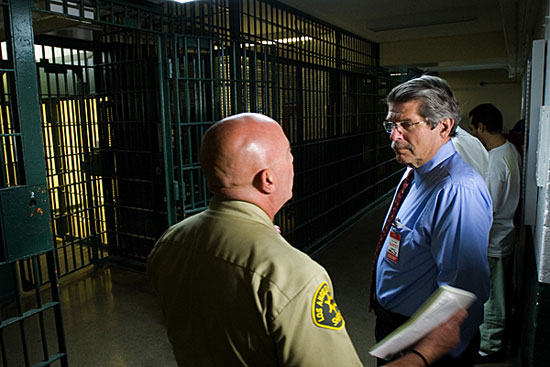The real work starts now
October 4, 2012

Supervisor Yaroslavsky visits Men's Central Jail shortly after creation of the blue-ribbon commission.
One year ago this month, the controversy over alleged deputy brutality inside the jail was threatening to utterly erode public confidence in the constitutional performance of the Los Angeles County Sheriff’s Department, our region’s largest law enforcement agency.
Not only were inmates accusing deputies of bone-breaking beatings but civilian observers—including a jail chaplain—had provided the American Civil Liberties Union with affidavits saying they’d witnessed fierce and unprovoked attacks. There were also revelations of a federal investigation into the widening allegations.
Under increasing fire, Sheriff Lee Baca publicly said at the time that his command staff had kept him in the dark about the problems but that he was determined to bring order and integrity to the county’s massive jail system—an entirely credible pledge given the sheriff’s longtime advocacy for inmate educational programs. To get to that point, however, would be no easy task.
In the midst of the uproar, I called Sheriff Baca and asked if I could meet with him in his office in Monterey Park. I arrived two hours later with a specific idea to help restore public trust in the department and in the broader leadership of the county, including the Board of Supervisors. One-on-one with the sheriff, I suggested that the board create a no-holds-barred blue-ribbon commission to investigate the origins of the jail problems and recommend reforms for the future. I believed that, with the sheriff on board, he’d be more likely to support the outcome.
He didn’t hesitate for a moment. Let the chips fall where they may, he said. Within days, I introduced a board motion with my colleague Mark Ridley-Thomas to create the Citizens’ Commission on Jail Violence. Its mandate: to excavate and expose the truth.
Last week this distinguished panel of seven commissioners released its final report. And it was, as we requested, unflinching in its assessment of what went wrong and what must be fixed. The bottom line was this: multi-faceted breakdowns in the management of the county’s jails—and deep flaws in the department’s disciplinary system—had created an environment ripe for unchecked brutality by deputies. The commission placed responsibility for these failings squarely on Baca and his second-in-command, Undersheriff Paul Tanaka. “Simply stated,” the panel wrote, “the Sheriff did not pay enough attention to the jails until external events forced him to do so.”
What makes the commission’s conclusions particularly difficult to ignore or dismiss is that they were rendered with unanimity by panelists of varying demographic and political stripes, from federal judges appointed by Republican and Democratic administrations, to the chief of police of Long Beach to a revered pastor in South Los Angeles.
Yesterday, Sheriff Baca summoned the media to Men’s Central Jail to comment publicly for the first time on the report, which not only took him to task but offered more than 60 recommendations for reform, including more rigorous independent oversight. “I couldn’t have written them better myself,” Baca said, reminding reporters that “I wanted this commission as much as the board did.” As he has done repeatedly over the past months, Baca again acknowledged his failings in the matter.
I appreciate and respect the sheriff’s willingness to publicly take responsibility for his department’s shortcomings, an admirable and longstanding characteristic of his management style. But the occasion at hand calls for more than words of contrition or pledges of reform that could fall short of their expressed ideals without sustained, aggressive action on the sheriff’s part.
The jail commission noted that their final report actually is just a starting point, something that all of us with a public responsibility—and a duty to uphold constitutional rights—should keep in mind. I pledge my support to do whatever I can to work with the Sheriff’s Department to bring about the kind of structural and cultural changes the commission has recommended. And above all, we must avoid the outcome the panel fears most: that the report will collect dust on a shelf, like too many reform efforts of the past.
Posted 10/4/12












 405 bridge work causes a stink
405 bridge work causes a stink





